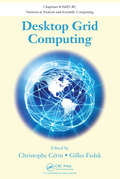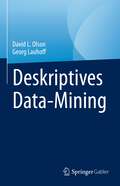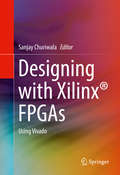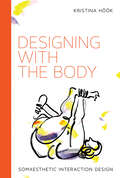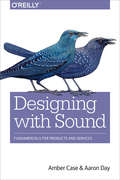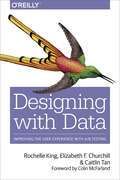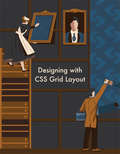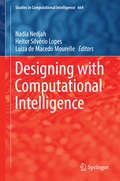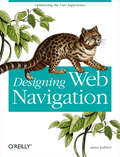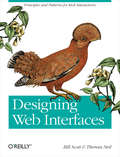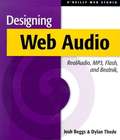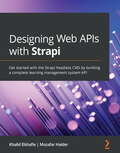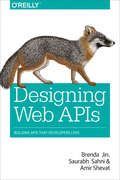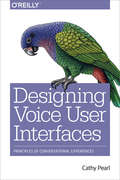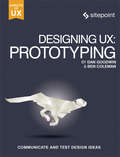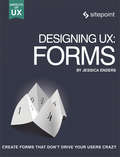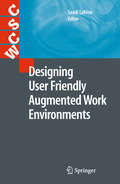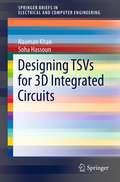- Table View
- List View
Desktop Grid Computing
by Christophe Cérin Gilles FedakDesktop Grid Computing presents common techniques used in numerous models, algorithms, and tools developed during the last decade to implement desktop grid computing. These techniques enable the solution of many important sub-problems for middleware design, including scheduling, data management, security, load balancing, result certification, and f
Deskriptives Data-Mining
by David L. Olson Georg LauhoffDieses Buch bietet einen Überblick über Data-Mining-Methoden, die durch Software veranschaulicht werden. Beim Wissensmanagement geht es um die Anwendung von menschlichem Wissen (Erkenntnistheorie) mit den technologischen Fortschritten unserer heutigen Gesellschaft (Computersysteme) und Big Data, sowohl bei der Datenerfassung als auch bei der Datenanalyse. Es gibt drei Arten von Analyseinstrumenten. Die deskriptive Analyse konzentriert sich auf Berichte über das, was passiert ist. Bei der prädiktiven Analyse werden statistische und/oder künstliche Intelligenz eingesetzt, um Vorhersagen treffen zu können. Dazu gehört auch die Modellierung von Klassifizierungen. Die diagnostische Analytik kann die Analyse von Sensoreingaben anwenden, um Kontrollsysteme automatisch zu steuern. Die präskriptive Analytik wendet quantitative Modelle an, um Systeme zu optimieren oder zumindest verbesserte Systeme zu identifizieren. Data Mining umfasst deskriptive und prädiktive Modellierung. Operations Research umfasst alle drei Bereiche. Dieses Buch konzentriert sich auf die deskriptive Analytik.Das Buch versucht, einfache Erklärungen und Demonstrationen einiger deskriptiver Werkzeuge zu liefern. Es bietet Beispiele für die Auswirkungen von Big Data und erweitert die Abdeckung von Assoziationsregeln und Clusteranalysen. Kapitel 1 gibt einen Überblick im Kontext des Wissensmanagements. Kapitel 2 erörtert einige grundlegende Softwareunterstützung für die Datenvisualisierung. Kapitel 3 befasst sich mit den Grundlagen der Warenkorbanalyse, und Kapitel 4 demonstriert die RFM-Modellierung, ein grundlegendes Marketing-Data-Mining-Tool. Kapitel 5 demonstriert das Assoziationsregel-Mining. Kapitel 6 befasst sich eingehender mit der Clusteranalyse. Kapitel 7 befasst sich mit der Link-Analyse. Die Modelle werden anhand geschäftsbezogener Daten demonstriert. Der Stil des Buches ist beschreibend und versucht zu erklären, wie die Methoden funktionieren, mit einigen Zitaten, aber ohne tiefgehende wissenschaftliche Referenzen. Die Datensätze und die Software wurden so ausgewählt, dass sie für jeden Leser, der über einen Computeranschluss verfügt, weithin verfügbar und zugänglich sind.
Desire2Learn for Higher Education Cookbook
by Brandon BallentinePart of Packt's Cookbook series; if you don't have the time to work your way through a long tutorial, then this is the book for you. The step-by-step recipes are independent from each other so you can dip in and out of the book or follow it from start to end to build a higher education course. If you're familiar with D2L's basic tools but want to do more with your course, then this book is for you.
Desinformationsangriffe auf Unternehmen abwehren: Das dunkle Geschäft mit Fake News & Co und wie man sie bekämpft
by Uwe WolffFake News ist für die allermeisten ein Begriff, den sie mit Politik und politischen Kampagnen in Verbindung bringen. Die verheerenden Auswirkungen sind bekannt (Brexit, Trump, AfD) Doch erst jetzt realisieren Unternehmen und Unternehmenslenker, dass auch sie Zielscheibe von Fake News werden können. Die ersten Unternehmen in Deutschland haben diese Desinformationsattacken bereits zu spüren bekommen. Die Folge: Wertverfall des Unternehmens, Aktienabstürze, Reputationsschaden sowie verunsicherte Mitarbeiter, Geschäftspartner und Banken. Die Ziele und Motive der Kommunikationsattacken sind vielfältig: Sie reichen von verärgerten Ex-Mitarbeitern, aggressiven Mitbewerbern bis hin zu Hedge-Fonds, die ein Unternehmen übernahmereif schießen wollen oder auf fallende Aktienwerte wetten. Den modernen Kommunikationsattacken steht ein wirkungsvolles und breit gefächertes Waffenarsenal im Bereich Internet und Social Media zur Verfügung, mit denen sich Fake News in Minutenschnelle Wirksam verbreiten lassen, sodass Unternehmen kaum mehr die Zeit haben, sich dagegen wirkungsvoll zu wehren. Dieses Buch richtet den Blick auf die neue Situation, in der sich die Unternehmen empfinden, und beschreibt die die empfindlichen Stellen. Es erläutert Kommunikationsattacken anhand von Beispielen und liefert zudem eine Handreichung für Unternehmen in Sachen Prävention und Detektion, aber auch im Abwehrkampf gegen gezielte unternehmensschädigende Informationsattacken.
Designs for Learning Environments of the Future
by Peter Reimann Michael J. JacobsonFew things are as certain as societal changes--and the pressing need for educators to prepare students with the knowledge and ways of thinking necessary for the challenges in a changing world. In the forward-thinking pages of Designs for Learning Environments of the Future, international teams of researchers present emerging developments and findings in learning sciences and technologies at the infrastructure, curricular, and classroom levels. Focusing on ideas about designing innovative environments for learning in areas such as biology, engineering, genetics, mathematics, and computer science, the book surveys a range of learning technologies being explored around the world--a spectrum as diverse as digital media, computer modeling, and 3D virtual worlds--and addresses challenges arising from their design and use. The editors' holistic perspective frames these innovations as not only discrete technologies but as flexible learning environments that foster student engagement, participation, and collaboration. Contributors describe possibilities for teaching and learning in these and other cutting-edge areas: Working with hypermodels and model-based reasoning Using visual representations in teaching abstract concepts Designing strategies for learning in virtual worlds Supporting net-based collaborative teams Integrating innovative learning technologies into schools Developing personal learning communities Designs for Learning Environments of the Future will enhance the work of a wide range of professionals, including researchers and graduate students in the learning and cognitive sciences, and educators in the physical and social sciences.
Designmethoden im Zeitalter ihrer technischen Reproduzierbarkeit (Würzburger Beiträge zur Designforschung)
by Gerhard Schweppenhäuser Judith-Frederike Popp Christian BauerDie Beiträge in diesem Band spiegeln den Stand der Reflexions- und Forschungsprozesse an der Fakultät Gestaltung der TH Würzburg-Schweinfurt, der HBKsaar und der New Design University in St. Pölten. Sie repräsentieren einen Prozess der Aufklärung, dessen Prüfstein Walter Benjamins Frage ist, wie sich ›die Art und Weise der Sinneswahrnehmung‹ geschichtlich gewachsener Kollektive durch neue Medientechnologien verändert.
Designing with Xilinx® FPGAs
by Sanjay ChuriwalaThis book helps readers to implement their designs on Xilinx#65533; FPGAs. The authors demonstrate how to get the greatest impact from using the Vivado#65533; Design Suite, which delivers a SoC-strength, IP-centric and system-centric, next generation development environment that has been built from the ground up to address the productivity bottlenecks in system-level integration and implementation. This book is a hands-on guide for both users who are new to FPGA designs, as well as those currently using the legacy Xilinx tool set (ISE) but are now moving to Vivado. Throughout the presentation, the authors focus on key concepts, major mechanisms for design entry, and methods to realize the most efficient implementation of the target design, with the least number of iterations.
Designing With the Mind in Mind: Simple Guide to Understanding User Interface Design Guidelines
by Jeff JohnsonUser interface (UI) design rules and guidelines, developed by early HCI gurus and recognized throughout the field, were based on cognitive psychology (study of mental processes such as problem solving, memory, and language), and early practitioners were well informed of its tenets. But today practitioners with backgrounds in cognitive psychology are a minority, as user interface designers and developers enter the field from a wide array of disciplines. <p><p>HCI practitioners today have enough experience in UI design that they have been exposed to UI design rules, but it is essential that they understand the psychological basis behind the rules in order to effectively apply them. In Designing with the Mind in Mind, best-selling author Jeff Johnson provides designers with just enough background in perceptual and cognitive psychology that UI design guidelines make intuitive sense rather than being just a list of rules to follow.
Designing with the Body: Somaesthetic Interaction Design (Design Thinking, Design Theory)
by Kristina HookInteraction design that entails a qualitative shift from a symbolic, language-oriented stance to an experiential stance that encompasses the entire design and use cycle. With the rise of ubiquitous technology, data-driven design, and the Internet of Things, our interactions and interfaces with technology are about to change dramatically, incorporating such emerging technologies as shape-changing interfaces, wearables, and movement-tracking apps. A successful interactive tool will allow the user to engage in a smooth, embodied, interaction, creating an intimate correspondence between users' actions and system response. And yet, as Kristina Höök points out, current design methods emphasize symbolic, language-oriented, and predominantly visual interactions. In Designing with the Body, Höök proposes a qualitative shift in interaction design to an experiential, felt, aesthetic stance that encompasses the entire design and use cycle. Höök calls this new approach soma design; it is a process that reincorporates body and movement into a design regime that has long privileged language and logic. Soma design offers an alternative to the aggressive, rapid design processes that dominate commercial interaction design; it allows (and requires) a slow, thoughtful process that takes into account fundamental human values. She argues that this new approach will yield better products and create healthier, more sustainable companies. Höök outlines the theory underlying soma design and describes motivations, methods, and tools. She offers examples of soma design “encounters” and an account of her own design process. She concludes with “A Soma Design Manifesto,” which challenges interaction designers to “restart” their field—to focus on bodies and perception rather than reasoning and intellect.
Designing with Sound: Fundamentals for Products and Services
by Amber Case Aaron DaySound can profoundly impact how people interact with your product. Well-designed sounds can be exceptionally effective in conveying subtle distinctions, emotion, urgency, and information without adding visual clutter. In this practical guide, Amber Case and Aaron Day explain why sound design is critical to the success of products, environments, and experiences.Just as visual designers have a set of benchmarks and a design language to guide their work, this book provides a toolkit for the auditory experience, improving collaboration for a wide variety of stakeholders, from product developers to composers, user experience designers to architects. You’ll learn a complete process for designing, prototyping, and testing sound.In two parts, this guide includes:Past, present, and upcoming advances in sound designPrinciples for designing quieter productsGuidelines for intelligently adding and removing sound in interactionsWhen to use voice interfaces, how to consider personalities, and how to build a knowledge map of queriesWorking with brands to create unique and effective audio logos that will speak to your customersAdding information using sonification and generative audio
Designing with Objects
by Avinash C. Kak* All code examples in the book are available for download on a companion site with resources for readers and instructors* A refreshing alternative to the rather abstract and dry explanations of the object-oriented design patterns in much of the existing literature on the subject* In 24 chapters, Designing with Objects explains well-known design patterns by relating them to stories from the Harry Potter series
Designing with Data: Improving the User Experience with A/B Testing
by Caitlin Tan Elizabeth F Churchill Rochelle KingOn the surface, design practices and data science may not seem like obvious partners. But these disciplines actually work toward the same goal, helping designers and product managers understand users so they can craft elegant digital experiences. While data can enhance design, design can bring deeper meaning to data.This practical guide shows you how to conduct data-driven A/B testing for making design decisions on everything from small tweaks to large-scale UX concepts. Complete with real-world examples, this book shows you how to make data-driven design part of your product design workflow.Understand the relationship between data, business, and designGet a firm grounding in data, data types, and components of A/B testingUse an experimentation framework to define opportunities, formulate hypotheses, and test different optionsCreate hypotheses that connect to key metrics and business goalsDesign proposed solutions for hypotheses that are most promisingInterpret the results of an A/B test and determine your next move
Designing with CSS Grid Layout
by Ahmad Ajmi Nitish Kumar Adrian RoworthLayout in CSS has always been a tricky task: hacking solutions using positioning, floats, and the one-dimensional flexbox has never been very satisfactory. Fortunately, there is a new tool to add to our arsenal: CSS Grid Layout. It is an incredibly powerful layout system that allows us to design pages using a two-dimensional grid - offering the kind of fine-grained layout control that print designers take for granted! Grid Layout has been in development for a while, but has recently been made a W3C candidate recommendation and has been added to most of the major browsers, so is ready for prime time. This short selection of tutorials, hand-picked from SitePoint's HTML & CSS channel, will get you up and running with Grid Layout and using it on your own sites in no time. This collection includes: An Introduction to the CSS Grid Layout Module by Ahmad AjmiSeven Ways You Can Place Elements Using CSS Grid Layout by Nitish KumarHow to Order and Align Items in Grid Layout by Nitish KumarA Step by Step Guide to the Auto- Placement Algorithm in CSS Grid by Nitish KumarHow I Built a Pure CSS Crossword Puzzle by Adrian Roworth This book is suitable for front end developers and web designers with some CSS experience.
Designing with Computational Intelligence
by Nadia Nedjah Heitor Silvério Lopes Luiza de Macedo MourelleThis book discusses a number of real-world applications of computational intelligence approaches. Using various examples, it demonstrates that computational intelligence has become a consolidated methodology for automatically creating new competitive solutions to complex real-world problems. It also presents a concise and efficient synthesis of different systems using computationally intelligent techniques.
Designing Web Navigation
by James KalbachThoroughly rewritten for today's web environment, this bestselling book offers a fresh look at a fundamental topic of web site development: navigation design. Amid all the changes to the Web in the past decade, and all the hype about Web 2.0 and various "rich" interactive technologies, the basic problems of creating a good web navigation system remain. Designing Web Navigation demonstrates that good navigation is not about technology-it's about the ways people find information, and how you guide them. Ideal for beginning to intermediate web designers, managers, other non-designers, and web development pros looking for another perspective, Designing Web Navigation offers basic design principles, development techniques and practical advice, with real-world examples and essential concepts seamlessly folded in. How does your web site serve your business objectives? How does it meet a user's needs? You'll learn that navigation design touches most other aspects of web site development. This book: Provides the foundations of web navigation and offers a framework for navigation design Paints a broad picture of web navigation and basic human information behavior Demonstrates how navigation reflects brand and affects site credibility Helps you understand the problem you're trying to solve before you set out to design Thoroughly reviews the mechanisms and different types of navigation Explores "information scent" and "information shape" Explains "persuasive" architecture and other design concepts Covers special contexts, such as navigation design for web applications Includes an entire chapter on tagging While Designing Web Navigation focuses on creating navigation systems for large, information-rich sites serving a business purpose, the principles and techniques in the book also apply to small sites. Well researched and cited, this book serves as an excellent reference on the topic, as well as a superb teaching guide. Each chapter ends with suggested reading and a set of questions that offer exercises for experiencing the concepts in action.
Designing Web Interfaces
by Bill Scott Theresa NeilWant to learn how to create great user experiences on today's Web? In this book, UI experts Bill Scott and Theresa Neil present more than 75 design patterns for building web interfaces that provide rich interaction. Distilled from the authors' years of experience at Sabre, Yahoo!, and Netflix, these best practices are grouped into six key principles to help you take advantage of the web technologies available today. With an entire section devoted to each design principle, Designing Web Interfaces helps you: Make It Direct-Edit content in context with design patterns for In Page Editing, Drag & Drop, and Direct Selection Keep It Lightweight-Reduce the effort required to interact with a site by using In Context Tools to leave a "light footprint" Stay on the Page-Keep visitors on a page with overlays, inlays, dynamic content, and in-page flow patterns Provide an Invitation-Help visitors discover site features with invitations that cue them to the next level of interaction Use Transitions-Learn when, why, and how to use animations, cinematic effects, and other transitions React Immediately-Provide a rich experience by using lively responses such as Live Search, Live Suggest, Live Previews, and more Designing Web Interfaces illustrates many patterns with examples from working websites. If you need to build or renovate a website to be truly interactive, this book gives you the principles for success.
Designing Web Audio
by Josh Beggs Dylan ThedeDesigning Web Audio is the most complete Internet audio guide on the market, loaded with informative real-world case studies and interviews with some of the world's leading audio and web producers. Its step-by-step instructions on how to use the most popular web audio formats to stream music make it an invaluable resource for web developers and web music enthusiasts.
Designing Web APIs with Strapi: Get started with the Strapi headless CMS by building a complete learning management system API
by Khalid Elshafie Mozafar HaiderLeverage the power of Strapi to build self-hosted, customizable, and performant content APIsKey FeaturesDiscover how Strapi can help you build APIs quickly and focus on your products and featuresLearn how to put Strapi into practice by implementing it in real-world scenariosUnderstand how to use Strapi's powerful features to customize your APIsBook DescriptionStrapi is a Node.js-based, flexible, open-source headless CMS with an integrated admin panel that anyone can use and helps save API development time. APIs built with Strapi can be consumed using REST or GraphQL from any client. With this book, you'll take a hands-on approach to exploring the capabilities of the Strapi platform and creating a custom API from scratch.This book will help JavaScript developers to put their knowledge to work by guiding them through building powerful backend APIs. You'll see how to effortlessly create content structures that can be customized according to your needs, and gain insights into how to write, edit, and manage your content seamlessly with Strapi. As you progress through the chapters, you'll discover a wide range of Strapi features, as well as understand how to add complex features to the API such as user authentication, data sorting, and pagination. You'll not only learn how to find and use existing plugins from the open-source community but also build your own plugins with custom functionality with the Strapi plugin API and add them to the admin panel. Finally, you'll learn how to deploy the API to Heroku and AWS.By the end of this book, you'll be able to build powerful, scalable, and secure APIs using Strapi.What you will learnExplore Strapi and understand how it worksDefine content types to build APIs quickly and efficientlyUnderstand authentication and authorization in StrapiCreate production-ready APIs with StrapiDeploy the Strapi API to various environments, including Heroku and AWSUse best practices to run the Strapi API in productionSync permissions to access the API between multiple environmentsWrite basic tests for API utilities as well as the endpointWho this book is forThis book is for backend and frontend JavaScript developers. Experienced API developers will learn a new, fast, and flexible way of building APIs, while frontend developers will be able to take a step toward becoming full-stack developers by learning how to leverage Strapi for building APIs quickly. Basic knowledge of JavaScript and REST API concepts is assumed.
Designing Web APIs: Building APIs That Developers Love
by Brenda Jin Saurabh Sahni Amir ShevatUsing a web API to provide services to application developers is one of the more satisfying endeavors that software engineers undertake. But building a popular API with a thriving developer ecosystem is also one of the most challenging. With this practical guide, developers, architects, and tech leads will learn how to navigate complex decisions for designing, scaling, marketing, and evolving interoperable APIs.Authors Brenda Jin, Saurabh Sahni, and Amir Shevat explain API design theory and provide hands-on exercises for building your web API and managing its operation in production. You’ll also learn how to build and maintain a following of app developers. This book includes expert advice, worksheets, checklists, and case studies from companies including Slack, Stripe, Facebook, Microsoft, Cloudinary, Oracle, and GitHub.Get an overview of request-response and event-driven API design paradigmsLearn best practices for designing an API that meets the needs of your usersUse a template to create an API design processScale your web API to support a growing number of API calls and use casesRegularly adapt the API to reflect changes to your product or businessProvide developer resources that include API documentation, samples, and tools
Designing Voice User Interfaces: Principles of Conversational Experiences
by Cathy PearlVoice user interfaces (VUIs) are becoming all the rage today. But how do you build one that people can actually converse with? Whether you’re designing a mobile app, a toy, or a device such as a home assistant, this practical book guides you through basic VUI design principles, helps you choose the right speech recognition engine, and shows you how to measure your VUI’s performance and improve upon it.Author Cathy Pearl also takes product managers, UX designers, and VUI designers into advanced design topics that will help make your VUI not just functional, but great.Understand key VUI design concepts, including command-and-control and conversational systemsDecide if you should use an avatar or other visual representation with your VUIExplore speech recognition technology and its impact on your designTake your VUI above and beyond the basic exchange of informationLearn practical ways to test your VUI application with usersMonitor your app and learn how to quickly improve performanceGet real-world examples of VUIs for home assistants, smartwatches, and car systems
Designing UX: Because Modern Design is Never Static
by Ben Coleman Dan GoodwinIt's well known that identifying and fixing problems in design is easier and cheaper if it can be done earlier in the process of design and build. That's because as the fidelity of the project we're working on increases, the effort involved in making changes increases. If we can test out early ideas to see if they work, in small chunks, then we can identify whether those ideas are going to work. To do this, we need to build prototypes. With easy-to-follow, practical advice, this book will show you how to use a number of different prototyping techniques to improve UX. It covers: The prototyping processPaper prototypingInteractive wireframing tools, such as Balsamiq and AxureDedicated prototyping tools, including Marvel, Invision, and Adobe XDHTML prototypesHow to use prototypes in your project workflow
Designing UX: Create Forms That Don't Drive Your Users Crazy
by Jessica EndersA recent study found that on average, designing a form to have a great user experience almost doubled the rate of successful first-time completions. For example, Ebay made an additional $USD 500 million annually from redesigning just the button on one of their mobile form screens. More conversions, fewer dissatisfied users, better return on investment. Can you afford not to improve your forms' user experiences? This book will walk you through every part of designing a great forms user experience. From the words, to how the form looks, and on to interactivity, you'll learn how to design a web form that works beautifully on mobiles, laptops and desktops. Filled with practical and engaging insights, and plenty of real-world examples, both good and bad. You'll learn answers to common queries like: Where should field labels go?What makes a question easy to understand?How do you design forms to work on small screens?How does touch impact on form design?How long can a form be?What look and feel should the form have: skeumorphic, flat, or something else?What's best practice for error messaging?
Designing User Friendly Augmented Work Environments
by Saadi LahlouThis book provides an overview and summary of the key research undertaken in augmented environments by some of the most prominent laboratories in the field worldwide (Stanford, Carnegie-Mellon, Fuji-Xerox Palo Alto, EDF R&D, Politecnico di Milano, Swedish Royal Institute of Technology, Russian Academy of Science, UC San Diego, University of Aachen). The book covers all relevant aspects of Augmented Environments from architecture to computer science and psychology. Most useful theories (activity theory, distributed cognition, cognitive attractors, perceived quality...) and design principles (COTS, semantic Rubicon, never-endingness...) as well as practical patterns for implementation are provided by the seminal authors themselves. With this overview, readers can benefit from the experiences of key researchers in the field to construct robust, efficient and user-friendly augmented. All those working in the field of human-computer interaction will find this book an invaluable reference source.
Designing Usable and Secure Software with IRIS and CAIRIS
by Shamal FailyEveryone expects the products and services they use to be secure, but 'building security in' at the earliest stages of a system's design also means designing for use as well. Software that is unusable to end-users and unwieldy to developers and administrators may be insecure as errors and violations may expose exploitable vulnerabilities. This book shows how practitioners and researchers can build both security and usability into the design of systems. It introduces the IRIS framework and the open source CAIRIS platform that can guide the specification of secure and usable software. It also illustrates how IRIS and CAIRIS can complement techniques from User Experience, Security Engineering and Innovation & Entrepreneurship in ways that allow security to be addressed at different stages of the software lifecycle without disruption. Real-world examples are provided of the techniques and processes illustrated in this book, making this text a resource for practitioners, researchers, educators, and students.
Designing TSVs for 3D Integrated Circuits
by Nauman Khan Soha HassounThis book explores the challenges and presents best strategies for designing Through-Silicon Vias (TSVs) for 3D integrated circuits. It describes a novel technique to mitigate TSV-induced noise, the GND Plug, which is superior to others adapted from 2-D planar technologies, such as a backside ground plane and traditional substrate contacts. The book also investigates, in the form of a comparative study, the impact of TSV size and granularity, spacing of C4 connectors, off-chip power delivery network, shared and dedicated TSVs, and coaxial TSVs on the quality of power delivery in 3-D ICs. The authors provide detailed best design practices for designing 3-D power delivery networks. Since TSVs occupy silicon real-estate and impact device density, this book provides four iterative algorithms to minimize the number of TSVs in a power delivery network. Unlike other existing methods, these algorithms can be applied in early design stages when only functional block- level behaviors and a floorplan are available. Finally, the authors explore the use of Carbon Nanotubes for power grid design as a futuristic alternative to Copper.
